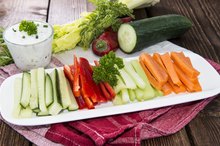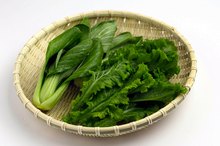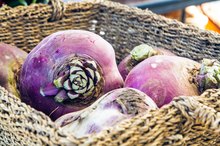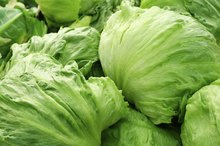Cauliflower Nutrition Guide
Whether boiled, steamed, mashed, roasted or eaten raw, cauliflower delivers great nutritional value with little nutritional cost. It's low in calories, fat and sodium but delivers fiber, vitamin C and potassium. Available year-round but especially plentiful in the fall, cauliflower is worth adding to the list of vegetables you make a point of eating regularly.
Calories, Fat and Cholesterol
Eating cauliflower can help fill you up without weighing you or your arteries down. Like most vegetables, cauliflower is remarkably low in calories, fat and cholesterol. According to the Centers for Disease Control (CDC), both cooked and raw cauliflower contain just 15 calories per half cup (one serving) and have 0 g of fat and 0 mg of cholesterol 1.
Sodium and Potassium
How Many Calories in Carrot Sticks?
Learn More
Cauliflower is low in sodium but delivers a good amount of potassium. Each half-cup serving of raw cauliflower contains 15 mg of sodium (1 percent of the recommended daily value), while each half cup of cooked cauliflower contains only 10 mg (0 percent of the recommended daily value). According to the U.S. Department of Agriculture, a half cup of raw cauliflower packs about 150 mg of potassium.
Carbohydrates, Fiber and Protein
Cauliflower is relatively low in both carbohydrates and protein but adds to your daily fiber intake. A half cup of raw or cooked cauliflower contains just 3 grams of carbohydrates (1 percent of the recommended daily value) and just 1 gram of protein. Cooked cauliflower delivers more fiber than raw cauliflower: 2 grams per serving (8 percent of daily value) as opposed to just 1 gram (4 percent).
Vitamins and Minerals
The Health Benefits of Cauliflower
Learn More
A serving of cauliflower contains none of your daily vitamin A, but considerable amounts of vitamin C, the CDC reports. A half cup of cooked cauliflower packs 45 percent of the recommended daily value of vitamin C, and a half cup of raw cauliflower has 40 percent. A serving of cauliflower, whether raw or cooked, contains just 2 percent of your iron and either 2 percent (raw cauliflower) or 0 percent (cooked cauliflower) of your daily calcium.
Selection
When shopping for cauliflower, choose heads that are solid, compact and heavy for their size. The surrounding green leaves should look fresh. The heads should be white or creamy white and free of brown spots and other blemishes. Adding milk or lemon juice during cooking helps keep those white heads white.
- When shopping for cauliflower, choose heads that are solid, compact and heavy for their size.
- Adding milk or lemon juice during cooking helps keep those white heads white.
Related Articles
References
- Centers for Disease Control: Cauliflower
- Cauliflower, raw. FoodData Central. U.S. Department of Agriculture. Published April 1, 2019.
- Slavin JL. Carbohydrates, dietary fiber, and resistant starch in white vegetables: Links to health outcomes. Advances in Nutrition. 2013;4(3):351S-5S. doi:10.3945/an.112.003491
- Moores CJ, Fenech M, O’Callaghan NJ. Telomere dynamics: The influence of folate and DNA methylation. Ann NY Acad Sci. 2011;1229:76-88. doi:10.1111/j.1749-6632.2011.06101.x
- Dahl WJ, Stewart ML. Position of the Academy of Nutrition and Dietetics: Health implications of dietary fiber. J Acad Nutr Diet. 2015;115(11):1861-70. doi:10.1016/j.jand.2015.09.003
- Pollock RL. The effect of green leafy and cruciferous vegetable intake on the incidence of cardiovascular disease: A meta-analysis. JRSM Cardiovasc Dis. 2016;5. doi:10.1177/2048004016661435
- Ahmed FA, Ali RF. Bioactive compounds and antioxidant activity of fresh and processed white cauliflower. BioMed Research International. 2013. doi:10.1155/2013/367819
- National Cancer Institute. Cruciferous vegetables and cancer prevention. Updated June 7, 2012.
- Scott O, Galicia-Connolly E, Adams D, Surette S, Vohra S, Yager JY. The safety of cruciferous plants in humans: A systematic review. J Biomed Biotechnol. 2012;2012:503241. doi:10.1155/2012/503241
- American Academy of Allergy Asthma and Immunology. Oral allergy syndrome (OAS) or pollen fruit syndrome (PFS).
- Bajaj JK, Salwan P, Salwan S. Various possible toxicants involved in thyroid dysfunction: A review. J Clin Diagn Res. 2016;10(1):FE01-3. doi:10.7860/JCDR/2016/15195.7092
- Cauliflower, pickled. FoodData Central. U.S. Department of Agriculture. Published April 1, 2020.
- Rice, white, cooked. FoodData Central. U.S. Department of Agriculture. Published April 1, 2019.
- Rice, brown, cooked. FoodData Central. U.S. Department of Agriculture. Published April 1, 2019.
- Riced cauliflower. FoodData Central. U.S. Department of Agriculture. Published April 1, 2019.
Writer Bio
Elisabeth Dahl is a freelance writer and copyeditor who has worked in publishing since 1991. She holds a Bachelor of Arts degree from Johns Hopkins University and a Master of Arts degree from Georgetown University, where she was a Writing Center Associate Fellow.









